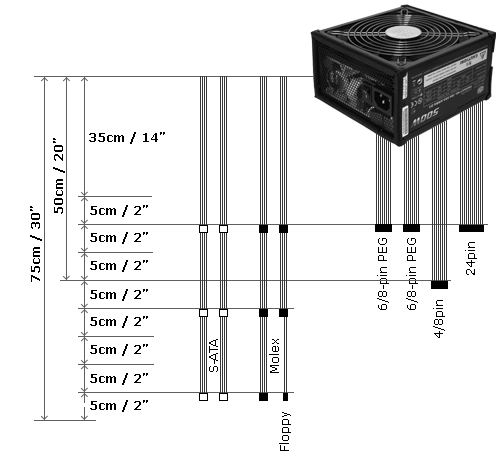Cooler Master Silent Pro PSUs
by Christoph Katzer on September 8, 2008 3:00 AM EST- Posted in
- Cases/Cooling/PSUs
Cables and Connectors

The cable management system is at the front of the power supply, as usual. There are two jacks for 6/8-pin PEG connectors (6+2 pins), providing support for up to two moderate graphics cards or a single high-end GPU. In addition there are four jacks that support flat 5-pin connectors used for the peripherals, supporting both SATA and Molex harnesses.

The maximum cable length of 70cm may not be long enough to reach all of the corners in larger cases, but the 500W rating suggests this is more for mid-towers where longer cable lengths aren't usually necessary. In particular, the main 24-pin ATX cable is only 40cm long, which could work either really well or not at all depending on the chassis. This power supply is a traditional design for top-mounted chassis, and it will definitely have problems if the PSU mounts at the bottom of the case. With six SATA, five Molex, and one floppy connector there are plenty of connectors for a normal midrange to high-end setup. If you need additional connections, you could always purchase splitter cables, but he might be better off simply purchasing a larger power supply in that case.
The Fan

Young-Lin makes the fan, a sleeve bearing fan with the model number DFS132512M. Noise levels as we will see later are quite good.










15 Comments
View All Comments
ryboto - Wednesday, September 17, 2008 - link
You're quite incorrect. The method for heat transfer from the heatsinks to the air is the same for both copper and aluminum. If you took a heat transfer course you'd know that the thermal conductivities and convective heat transfer coefficients are what is used in the heat transfer equations. No where is it dependent on the heat capacity. So, you haveQ=K A (Tb-Th) where Tb=base temp, Th= heatsink temp, then heat transfer to the air is
Qa=h A (Th-Ta) where Ta is the bulk air temp. These are highyl approximated, as there are multiple layers. Now, look at the equations...if K for Cu is greater than for Al, heat transfer is faster. What this amounts to is a greater Th, but look at the second equation, if Th is greater, the temperature gradient(or driving force for heat transfer) is greater than it would be for aluminum. Copper is a better material for this application. It's just expensive, and it oxidizes, which is why we have nickel plated copper heatpipes.
Megaknight - Tuesday, September 9, 2008 - link
Great explanation mate.Penti - Monday, September 8, 2008 - link
It's an old tale but it's just that a tale.Weight has probably a lot to do with it on modern coolers, I have a Tuniq Tower 120, think of this cooler in pure copper, it would snap the motherboard with it's weight probably. We haven't moved to coolers weighing 2-3 kg yet. But as always price is the main factor.
Aquila76 - Monday, September 8, 2008 - link
'Transfer' and 'dissipate' are different things. The copper plates transfer heat away from the components better; the aluminum fins dissipate (exchanges may have been a better word choice there) the heat into the air. This is not unlike those heatpipe tower-style CPU coolers.Christoph Katzer - Monday, September 8, 2008 - link
Thanks mate.